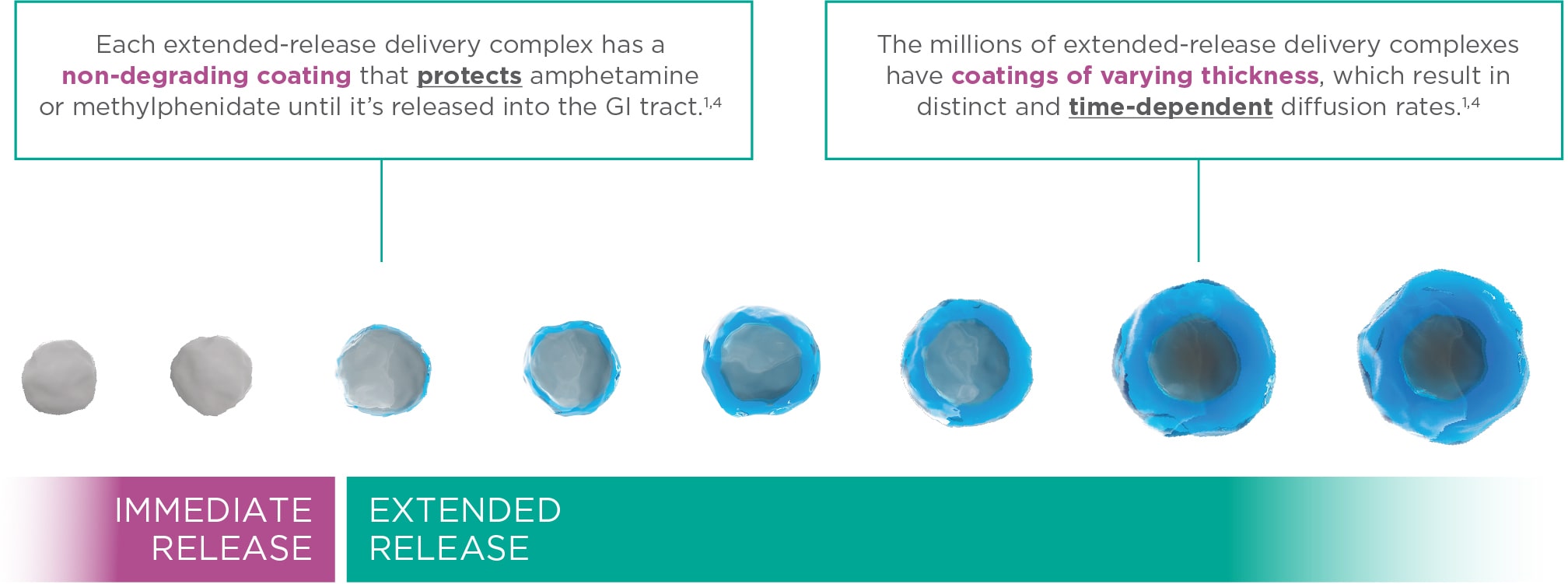ADHD Innovation

Innovative technology provides consistent drug delivery and predictable
symptom control from patient to patient through the day 1-3
IR complexes come into contact with positively charged exchange ions from gastrointestinal fluid, displacing ions and releasing medication 2
ER complexes have coatings of variable thickness that enable a controlled release of medication through diffusion and ion exchange 2

Our technology puts your patient first
Drug releases slowly throughout the day and is not affected by:4,5
- Timing or type of food consumed
- pH of the GI tract
- Location of release in GI tract
- Amphetamine or methylphenidate metabolism
See how it works
Unique Technology is at the core of all Tris ADHD products
Tris Pharma offers amphetamine and methylphenidate treatment options for patients 6 years and older with ADHD.
Select a product below.
 Dyanavel XR extended release oral suspension
Dyanavel XR extended release oral suspension
 QuilliChew ER, the only once-daily extended-release methylphenidate tablet
QuilliChew ER, the only once-daily extended-release methylphenidate tablet
 Quillivant XR, the first once-daily, long-acting* liquid methylphenidate treatment
Quillivant XR, the first once-daily, long-acting* liquid methylphenidate treatment
Help your patients save on Tris ADHD products.
ADHD, Attention Deficit Hyperactivity Disorder; ER, extended-release; IR, immediate-release; pH, potential of hydrogen.
References: 1. Kando JC, King TR, Pardo A. A novel, modified-release drug delivery technology containing amphetamine and methylphenidate ion-exchange complexes. Poster presented at: American Psychiatric Association Annual Meeting; May 1-3, 2021. 2. Cutler AJ, Pardo A, King TR, et al. Randomized, double-blind, placebo-controlled, fixed-dose study to evaluate the efficacy and safety of the amphetamine extended-release tablet in adults with attention-deficit/hyperactivity disorder. Poster presented at 2021 APSARD; January 15-17. 3. Childress AC, Wigal SB, Brams MN, et al. Efficacy and safety of amphetamine extended-release oral suspension in children with attention-deficit/hyperactivity disorder. J Child Adolesc Psycholpharmacol. 2018;28(5):306-313. 4. Herman BK, King TR, Kando JC, et al. A novel, modified release drug delivery technology (LiquiXR®) containing amphetamine ion-exchange complexes. Poster presented at: Psych Congress; October 3-6, 2019. San Diego, CA. 5. Powell JJ, Greenfield SM, Thompson RP. Concentrations of metals in gastric juice in health and peptic ulcer disease. Gut. 1992;33(12):1617-1620.



